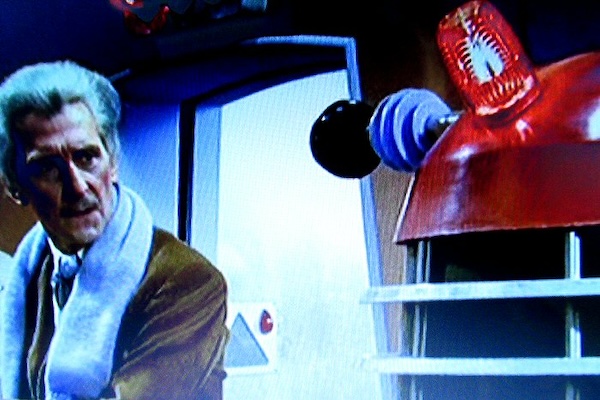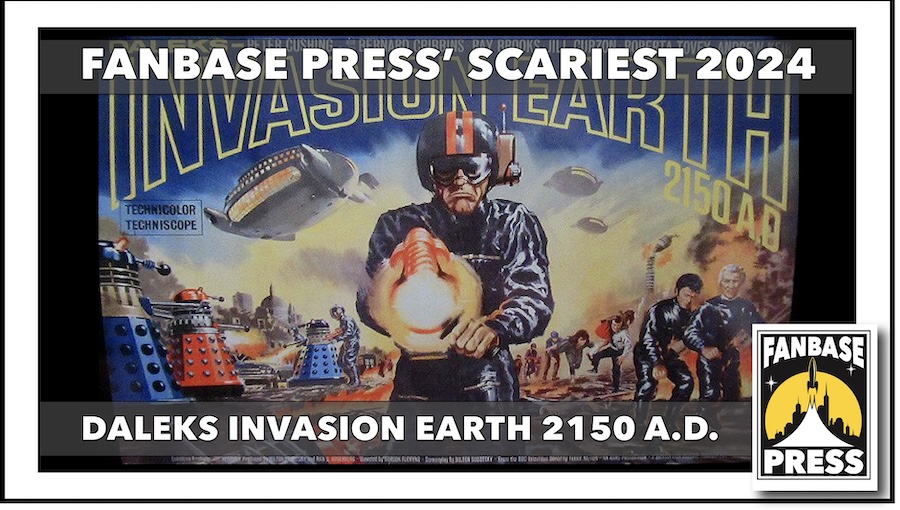As Halloween is fast approaching, the Fanbase Press staff and contributors decided that there was no better way to celebrate this horrifically haunting holiday than by sharing our favorite scary stories! Be they movies, TV shows, video games, novels, or any other form of entertainment, members of the Fanbase Press crew will be sharing their “scariest” stories each day leading up to Halloween. We hope that you will enjoy this sneak peek into the terrors that frighten Fanbase Press!
“We can’t fight metal with flesh and blood.”
And yet, in the 1966 feature film, Daleks Invasion Earth 2150 A.D., directed by Gordon Flemyng and starring Peter Cushing, Bernard Cribbins, Jill Curzon, Roberta Tovey, and Andrew Kier, we give it a good try.
The second of what was originally to be a trilogy of Doctor Who features, Invasion Earth begins with Special Constable Tom Campbell attempting to foil a burglary. But after dashing into the local police box to call for help, and with no one around to shout, “Dude, that isn’t a police box,” he’s invariably whisked off on an adventure with Doctor Who, niece Louise, and granddaughter Susan in the Tardis, and on arrival at the same spot in the year 2150, he discovers things have changed dramatically and not for the better.
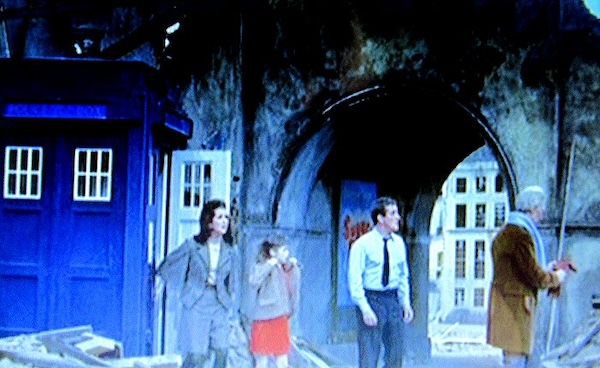
On a revisit, it’s easy to dismiss the film as lame kid’s stuff, hampered by Peter Cushing’s terrible wig, the plucky youngster dialogue, and the craziest flying saucer ever (more about that in a minute); however, it also carries some strong underpinnings, from the burden of recent history, of World War 2 (which ended only 21 years prior), to inspiration taken from H.G. Wells’ science fiction classic War of the Worlds. Was Invasion just another reflection of the current spirit of the times? (More about that later, too.)
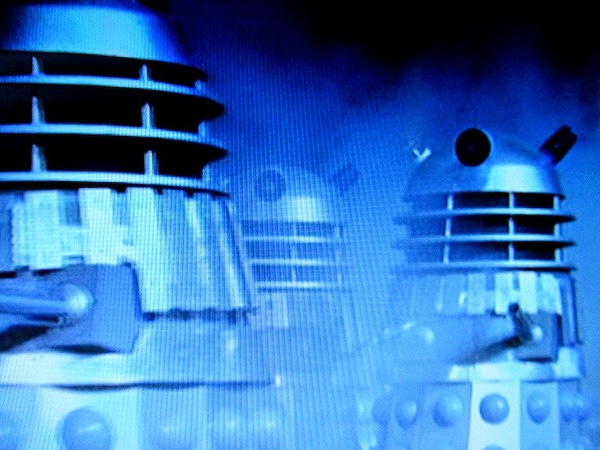
And let’s not forget the impact of the Daleks. What I remember as a child is gathering at Grandma’s for tea and having to suffer through the racing results, the football scores, and maybe ten minutes of headline news on the telly before Doctor Who began, and finally(!) we were off on an adventure in the Tardis. One thing the early shows were very good at—an early iteration of the jump scare, where they’d build up the tension, right before a Dalek would come rolling around the corner, armed with its eye on a stalk, a death ray, and a toilet plunger, and we’d all dive behind the couch to the battle cry of “Exterminate! Exterminate!” because we knew someone was about to get killed or worse.
The creatures have evolved over the years, better tech, better maneuverability, and via shows like Genesis of the Daleks, we’ve learned a lot more about them, too. They remain an enduring cultural icon, immediately recognizable, along with the fear of what they represent.
As for the flying saucer, check it out—
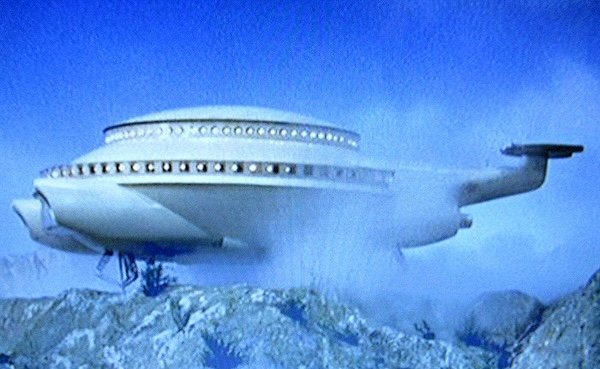
Is it a teapot, or a giant roast chicken? I can never make up my mind. Although, on second thought, it’s probably the best flying saucer I have ever come across, and in the era of models, projections, and matte paintings (No modern CGI here.), it looks pretty darned cool.
Okay, back to the story.
On arrival in London 2150, the Doctor, Louise, Susan, and Tom decide to explore the post-apocalyptic landscape and immediately become separated. Tom and the Doctor are captured by the Daleks, while Louise and Susan encounter one of the resistance fighters and are led to safety in the London Underground.
Here, we discover the Daleks are forcing people into labor at a mine in Bedfordshire and members of the resistance are planning an attack against the saucer. Louise joins the battle, which proves to be an unmitigated disaster, although it serves to allow the Doctor and Tom to escape their immediate fate of being robotized and used as mindless guards in the service of their tin can overlords.
In the confusion, although the Doctor manages to escape the ship, Louise and Tom remain stuck aboard the vessel, Louise in the relative safety of a storage cupboard, while Tom attempts to blend in with the Robomen with hilarious results. Hats off to Bernard Cribbins, an established comedic actor, for providing a much-needed light moment as he attempts to copy his robotized companions’ actions with hilarious results.
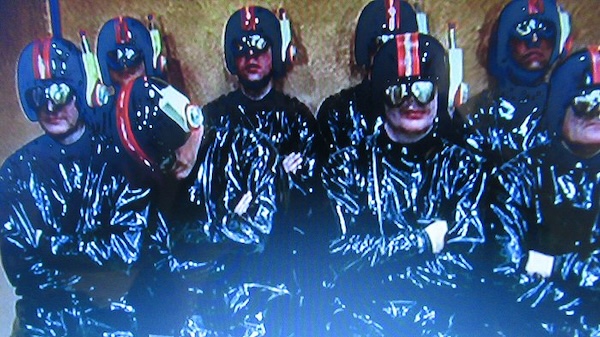
Unfortunately for young Susan, back at the rebels’ base, things aren’t looking so good. Only one raider, Wyler, returns from the attack, and after a decision is made to leave the city and regroup, Susan leaves a message on the door for the Doctor, and off they drive in a small red van.
However, the flying saucer has recently taken off and the Daleks spot them en route as they race into the countryside. One death ray from the giant roast chicken and it’s all over for the van. Thankfully, Susan and Wyler manage to leap out of the vehicle before it explodes into flames, and from then on they’ll have to travel on foot.
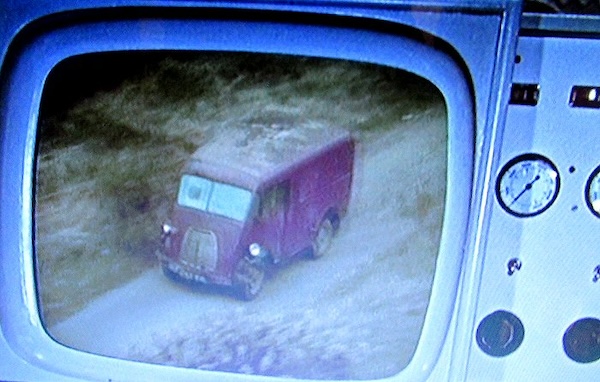
Meanwhile, Doctor Who and another surviving rebel, David, make it back to the Underground base and find it deserted. They check the maps of the Bedfordshire site and decide to investigate, hoping to pick up young Susan and the others on the way. Do they spot Susan’s message? (It’s right behind you!) No, they do not.
At this point, as any city slicker will tell you, if you think it’s bad in the city, wait until you venture forth into the countryside, where treachery and its twin brother betrayal gleefully await. Susan and Wyler are sheltered by two women, only to be handed over to the Daleks in exchange for food, while the Doctor and David fare no better as some bloke in a posh raincoat turns up at their campfire, steals their rifle, and offers to sneak them into the Bedfordshire mine by way of recompense.
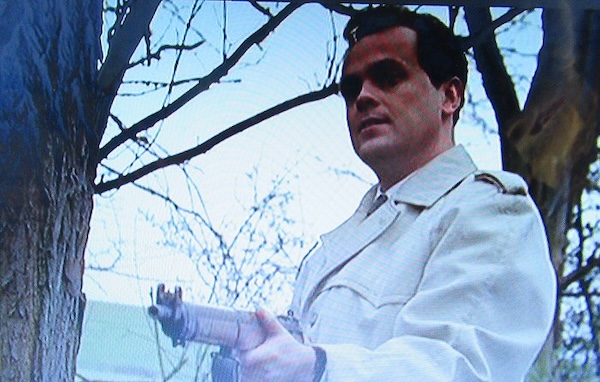
As for Tom and Louise, they’ve managed to reunite and have successfully hidden from the Daleks, and when the flying saucer lands, they make their escape and hide in a large tool shed. As luck would have it, the Doctor and David are also led to the tool shed by the bloke in the raincoat, and one of the workers there explains what’s going on. And thank goodness for that, because we’re all wondering just what the heck is going on in Bedfordshire.
The Daleks’ plan is to burrow toward the Earth’s core, drop a bomb down the shaft, remove the core, and replace it with a gadget that will allow them to steal away the Earth, lock, stock, and barrel, and pilot the planet to any destination they fancy.
This is wild, far-out stuff, but thankfully, we’re given a better illustration of the threat via a visit to the Daleks’ control room at the mine, and we get a good look at the bomb—an enormous, bright red contraption, and if we can stop all of that, we’ll be good to go.
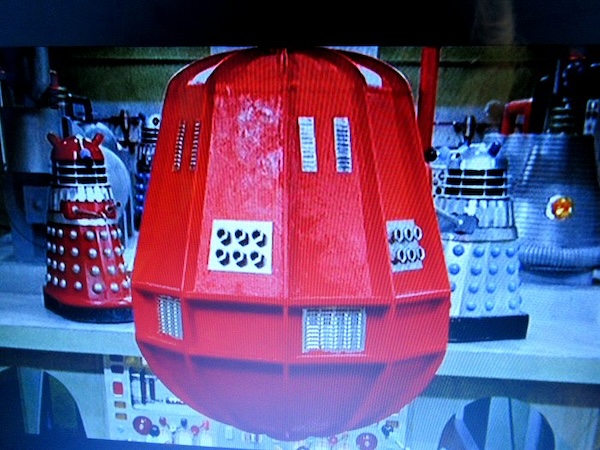
The Doctor finds a flaw in the plan involving an older, established mine shaft, and the Earth’s magnetic poles and hatches a counter plot. Done right, the Daleks will be sucked into the Earth’s core, and we can all go home. Tom heads off into the older mine shaft, while Louise dashes off to help evacuate everyone. But before the Doctor can make a move, he’s betrayed by the bloke in the raincoat who’s told the Daleks there’s someone hiding in the tool shed. (The bloke in the raincoat gets his comeuppance, by the way. Oh, yes, he does.)
Doctor Who is taken to the control room and manages to collect Wyler and Susan on the way. He spots Tom down the mine shaft and tries to give him time to figure out how to deflect the bomb by yelling into the radio and turning the Robomen against their masters.
A mighty battle follows and Dalek wrestling begins. Enough people, working together, one mighty shove and they’re over. Unfortunately, chaos reigns over the proceedings, the rebellion is defeated, and the countdown, in Rels, begins.
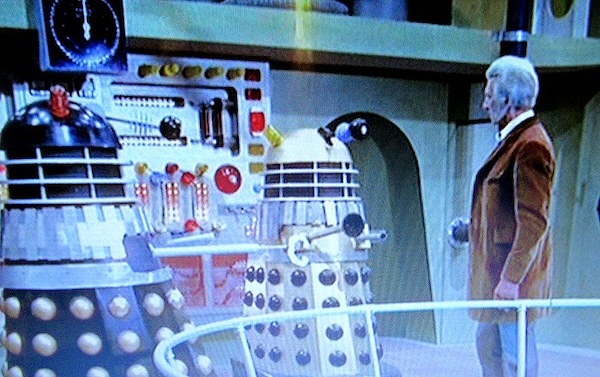
Fortunately, in the pit below the control room, Tom has thrown planks of wood across the mine shaft, sending the released bomb bouncing off on another trajectory. The Doctor’s plan works and the Daleks are sucked down toward the Earth’s core. Even the flying saucer falls foul of the magnetic poles’ convergence, crashes in spectacular fashion, and the Daleks are defeated.
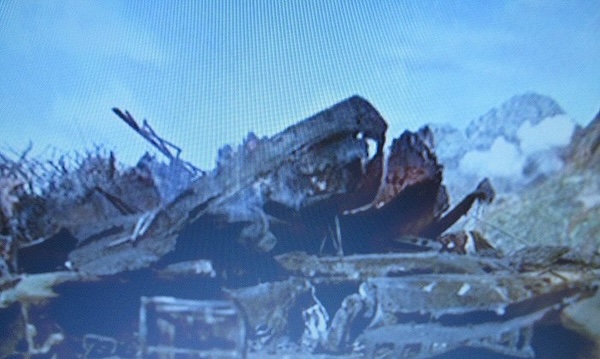
For now.
And okay, sure, the film ends on a lighthearted note. The battle has been won and Tom, courtesy of the Tardis, returns home a little early and arrests his burglars, just as they’re about to make their getaway. A kindly Doctor Who and his companions wave goodbye before setting off on another adventure, and yet, and yet, anxiety remains with us, a quiet horror, swirling around the destroyed city of London like a low, poisonous mist.
As kids growing up through the Cold War, we were told World War 2 was over, and yet no one had put down their weapons. Years have gone by and other conflicts have risen and fallen, like a deadly game of whack-a-mole where one war ends and another begins. That spirit of the times I mentioned at the beginning, that zeitgeist, is it any better now, or has it just gotten worse?
If Invasion offers us anything at all, it’s that there’s always hope while there’s something worth fighting for, and there is always something worth fighting for, whether it’s rescuing our beloved planet, experiencing a sunset, or simply being able to get out of bed in a morning without falling into a pit of nihilism and depression.
Even an imaginary creature such as the Doctor thought so, otherwise, he would have left our hearts and minds and disappeared a long time ago.
